Albert Lebourg
| Albert Lebourg | |
|---|---|
 Albert Lebourg, Self Portrait | |
| Born |
Albert Marie Lebourg 1 February 1849 Montfort-sur-Risle, France |
| Died |
6 January 1928 (aged 78) Rouen, France |
| Nationality | French |
| Education | École des Beaux-Arts de Rouen |
| Known for | Painting |
| Movement | Impressionism, Post-Impressionism, Rouen School |
| Awards | Officer of the Legion of Honour |
Albert Lebourg (1 February 1849, Montfort-sur-Risle – 6 January 1928, Rouen), birth name Albert-Marie Lebourg, also called Albert-Charles Lebourg and Charles Albert Lebourg,[1][2] was a French Impressionist and Post-Impressionist landscape painter of the Rouen School (l'École de Rouen). Member of the Société des Artistes Français, he actively worked in a luminous Impressionist style, creating more than 2,000 landscapes during his lifetime. The artist was represented by Galerie Mancini in Paris in 1896, in 1899 and 1910 by Galerie Bernheim-Jeune, 1903 and 1906 at the Galerie Paul Rosenberg, and 1918 and 1923 at Galerie Georges Petit.
Early life
Initially studying at Évreux Lycée, Albert Lebourg, with interests in architecture,[3] entered the École des Beaux-Arts of Rouen at a very young age. He studied art with Gustave Morin at l'Academie de peinture et de dessins, Rouen.[4] Afterward, the artist was briefly a student of Jean-Paul Laurens.[3] In 1876, Lebourg exhibited his works for the first time together with Claude Monet, Alfred Sisley, Pierre-Auguste Renoir, and other artists on the Boulevard Montmartre.[3] Lebourg was referred to be appointed as a drawing professor at the Société des Beaux-Arts in Algiers after being noticed in Rouen by the art collector Laurent Laperlier. There he met Jean Seignemartin, who he inspired to bring more clarity and light into his paintings. In 1873 Lebourg married and remained in Algiers until the summer of 1877 when he resigned from his teaching position and returned to Paris with numerous paintings of the casbah, mosques and the Admiralty.[5]
Career
In the Fourth Impressionist Exhibition of 1879 Lebourg exhibited 30 works with Claude Monet, Camille Pissarro and Edgar Degas, presenting paintings and drawings executed in Algiers. In the Fifth Impressionist Exhibition or 1880 he exhibited 20 works depicting Rouen, Paris and Algiers. In 1883 he was admitted to the Salon (Paris) with his work entitled Matinée à Dieppe.[5] In 1887 he exhibited at the acclaimed Les XX exhibition, with Walter Sickert,[6] Camille Pissarro, Berthe Morisot and Georges-Pierre Seurat exhibit, with Seurat and Signac present at the opening.[7] The major work shown is Seurat's A Sunday Afternoon on the Island of La Grande Jatte.[8]

Lebourg remained occupied in all four seasons painting animated scenes of the Seine in and near Rouen and Paris. He energetically painted in Auvergne, Normandy and Île-de-France, finally settling in Puteaux where he remained from 1888 to 1895, availing himself to the surroundings of Paris, painting what he would regard as his best works. He wrote at the time:
- "I will paint often at the banks of the Seine: Nanterre, Rueil, Chatou, Bougival, Port-Marly. These are a source of themes and very beautiful landscapes". (Lebourg)[5]
He became a member of the Société des Artistes Français beginning in 1893.[3]
Lebourg moved to the Netherlands in 1895, where he would stay two years. He exhibited to great acclaim at the Mancini Gallery in Paris and won the Silver Medal at the Exposition Universelle (1900). In 1903 a retrospective exhibition was organized presenting 111 works at the Gallerie Rosenberg, the art gallery of Paul Rosenberg at 21 rue de la Boétie in Paris. While his fame was firmly established by 1910 he continued exhibiting annually at the Salon. In 1918 another retrospective was organized in Paris.[5]
At the home of Impressionist art collector François Depeaux (1853-1920), Lebourg had the opportunity to converse many times with Camille Pissarro, Claude Monet, and Robert Antoine Pinchon (an artist who greatly admired him).[9][10]
13 November 1909, the Musée des Beaux-Arts de Rouen opened a show with fifty-two paintings: thirteen by Lebourg, three by Monet, nine by Sisley, one by Renoir, three by Armand Guillaumin, five by Joseph Delattre, two by Charles Frechon and four by Robert Antoine Pinchon.[11] And in 1918, in the same museum, Lebourg was represented along with Bonnard, Boudin, Camoin, Cross, Guillaumin, Luce, Matisse, Monet, Signac and Vuillard and Pinchon.[11]
He suffered a stroke in September 1920 that paralyzed the left side of his body. He nevertheless remarried in February 1921. A Catalogue Raisonné was organized that year that included 2,137 works and was released in 1923, which garnered united praise by the press.[5][12]
He was named Chevalier of the Legion of Honour on 27 June 1903, and breveted Officer of the Legion of Honour 22 April 1924[13]
Albert Lebourg died in Rouen on 7 January 1928. Lebourg’s works are exhibited at the Musée d’Orsay, Petit-Palais and Carnavalet in Paris, as well as museums in Bayonne, Clermont-Ferrand, Le Havre, Dunkerque, Lille, Strasbourg, Sceaux and above all Rouen at the Musée des Beaux-Arts de Rouen (François Depeaux collection).[5]
Selected works
- Lebourg, Le quai de la Tournelle et Notre-Dame de Paris, 1909, Musée Marmottan Monet, Paris
- View of Pont-du-Château, 1885, Hermitage Museum, Saint Saint Petersburg
- Remorqueurs à Rouen, Musée d'Orsay, Paris
- L'Île Lacroix sous la neige, Musée des Beaux-Arts de Rouen
- Navire norvégien dans le port de Rouen, Musée des Beaux-Arts de Rouen
- La Seine à Rouen, Musée des Beaux-Arts de Lyon
- La Seine à Croisset, Musée de la Chartreuse de Douai
- Faure Museum (Aix-les-Bains), Savoie
- Neige à Pont-du-Château, 1885, Musée d'art Roger-Quilliot, Clermont-Ferrand
- Neige à Pont-du-Château, Au Musée d'Évreux (Dépôt du Musée du Louvre), 1983, (inv. R.F. 1973-6).
- Vue de la Seine au bas Meudon, 1893, Musée de l'Île-de-France, Sceaux, Hauts-de-Seine
- Le pont de Neuilly du côté de Courbevoie, Musée de l'Île-de-France, Sceaux, Hauts-de-Seine
- The Seine at La Bouille, ca.1904-10, National Museum of Western Art, Tokyo
- La Seine près de Saint-Cloud, North Carolina Museum of Art
- Le Port d'Anvers (The Harbor at Anvers), 1895-1897, Phoenix Art Museum
- "La Rue de Bouchers à Algers, 1873, Ger Eenens Collection the Netherlands
Gallery
 Bords de Seine à Chatou, oil on canvas, 46.4 by 65.1 cm (18.25 by 25.6 in)
Bords de Seine à Chatou, oil on canvas, 46.4 by 65.1 cm (18.25 by 25.6 in) "La Rue de Bouchers à Algers, 1873, Ger Eenens Collection the Netherlands
"La Rue de Bouchers à Algers, 1873, Ger Eenens Collection the Netherlands Chalou Moulineux, 1910
Chalou Moulineux, 1910 Bateau à vapeur à Croisset, 60.9 × 103.5 cm (24 × 40.7 in)
Bateau à vapeur à Croisset, 60.9 × 103.5 cm (24 × 40.7 in) Notre-Dame de Paris et la Seine pendant l'inondation de 1910, 50.8 × 73.8 cm (20 × 29.1 in)
Notre-Dame de Paris et la Seine pendant l'inondation de 1910, 50.8 × 73.8 cm (20 × 29.1 in) Canal in Holland near Rotterdam', ca.1890
Canal in Holland near Rotterdam', ca.1890 Le Chevet de Notre-Dame, ca.1900, 25 × 34 cm (9.8 × 13.4 in)
Le Chevet de Notre-Dame, ca.1900, 25 × 34 cm (9.8 × 13.4 in)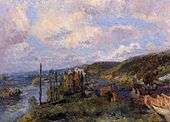 Near Rouen, The Cliffs of Saint Adrien, ca.1890
Near Rouen, The Cliffs of Saint Adrien, ca.1890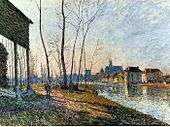 Moret sur loing un matin de fevrier, ca.1900
Moret sur loing un matin de fevrier, ca.1900- Notre Dame de Paris, View from the Quay de Tournelle, ca.1895
 Vue d'Évreux avec la cathédrale Notre Dame, ca.1897, 46 × 65 cm (18.1 × 25.6 in)
Vue d'Évreux avec la cathédrale Notre Dame, ca.1897, 46 × 65 cm (18.1 × 25.6 in) The Bridge over the Allier at Pont-du-Chateau in Winter, 1886, 43.6 x 77.7 cm
The Bridge over the Allier at Pont-du-Chateau in Winter, 1886, 43.6 x 77.7 cm Les anciens moulins du port de rotterdam un jour de grand vent, ca.1890
Les anciens moulins du port de rotterdam un jour de grand vent, ca.1890 Paris, l'écluse de la Monnaie. Soleil d'hiver, before 1918, 81.5 x 115.5 cm, Musée d'Orsay, Paris
Paris, l'écluse de la Monnaie. Soleil d'hiver, before 1918, 81.5 x 115.5 cm, Musée d'Orsay, Paris Tow boats in Rouen Sun ca.1900
Tow boats in Rouen Sun ca.1900 La Seine à Dieppedalle, environs de Rouen, ca.1900
La Seine à Dieppedalle, environs de Rouen, ca.1900 Paris, le pont de l’Archevêché et Notre-Dame vus du Quai de la Tournelle, ca.1890
Paris, le pont de l’Archevêché et Notre-Dame vus du Quai de la Tournelle, ca.1890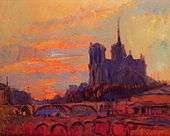 View of Notre Dame and the Seine, ca.1895
View of Notre Dame and the Seine, ca.1895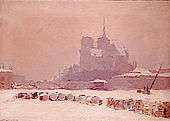 La Notre Dame, neige, ca.1895
La Notre Dame, neige, ca.1895- The small branche of the Seine at Bras Meudon, Snow and Sunlight, ca.1890
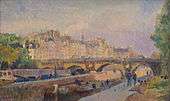 Paris, le pont Neuf, 1906, Petit Palais, Paris
Paris, le pont Neuf, 1906, Petit Palais, Paris
</gallery>
Further reading
- Léonce Bénédite, Albert Lebourg, Georges Petit, Paris, 1923
- François Lespinasse, L'École de Rouen, Fernandez, Sotteville-lès-Rouen, 1980
- François Lespinasse, Albert Lebourg 1849-1928, Rouen, 1983
- François Lespinasse, L'École de Rouen, Lecerf, Rouen, 1995 ISBN 2-901342-04-3
- L'École de Rouen de l'impressionnisme à Marcel Duchamp 1878-1914, Musée des Beaux-Arts de Rouen, 1996 ISBN 2-901431-12-7
- Marc-Henri Tellier, François Depeaux (1853-1920) le charbonnier et les impressionnistes, Rouen, Editions Marc-Henri Tellier, 2010 ISBN 9782746605152
- Mathilde Legendre et François Lespinasse, Albert Lebourg, Itinéraire d'un impressionniste normand, Pont-Audemer, édité en 2009 et réédité en janvier 2012 ISBN 978-2-918923-04-6, Musée Alfred-Canel, p. 82, (exhibition 10 October 2009 through 17 January 2010).
- Albert Lebourg: Peintre Paysagiste, November 1955, Gimpel Fils, 1955
- Armand Guillaumin and Albert Lebourg, Barbizon House (London, England), 1930
- Exposition Albert Lebourg: 23 novembre - 20 décembre 1976
- Exhibition of Paintings with Works by Albert Lebourg, Barbizon House, 1930
- Albert Lebourg, 1849-1928, Musée Eugène Boudin (Honfleur, Calvados), Musée de la Chartreuse (Douai, Nord), 1989
- Albert Lebourg (1849-1928): Documentation... Jean-Albert Cartier, 1955
- Albert Lebourg: un impressionniste au fil de l'eau, Musée Fournaise (Chatou, Yvelines), 2002
- Le Paysagiste Albert Lebourg, Samuel Frère, 1911
- 100 dessins par Albert Lebourg, Hôtel Drouot, 1986
- Les cahiers d'art-documents: Albert Lebourg, 1849-1928, 1955
- Exposition A. Lebourg (1849-1928), Galerie Serret-Fauveau, 1955
- Exposition de tableaux par Albert Lebourg: appartenant à divers amateurs au profit des sinistrés du Japon : ouverte du 3 au 19 novembre 1923, Galeries Georges Petit, 1923
- Le paysagiste Albert Lebourg, 1910
- Albert Lebourg, itinéraire d'un impressionniste normand, Mathilde Legendre, François Lespinasse, Musée Alfred Canel (Pont-Audemer, Eure), 2012
- Exposition rétrospective des oeuvres d'Albert Lebourg du 30 avril au 29 mai 1932 [Rouen, Musée], 1932
- L'Oeuvre d'Albert Lebourg dans les collections publiques, Madame Marcais, 1983
- Tableaux par A. Guillaumin et Albert Lebourg, Hôtel Drouot, 1937
- Exposition rétrospective des œuvres de Lebourg, Albert Lebourg, Galerie Haussmann,
- Albert Lebourg: 1849-1928 : Exposition du 26 mai au 27 juin 1970, Issue 2, Galerie Jean-Paul Wick [Paris], 1970
- American Art Association, François Charles Cachoud, 1928
- Neo-impressionist Painters: A Sourcebook on Georges Seurat, Camille Pissarro [...], Russell T. Clement, Annick Houzé, 1999
- Gauguin and Impressionism, Richard R. Brettell, Anne-Birgitte Fonsmark, 2007
- Modern France. A Companion to French Studies, Arthur Tilley, 1967
- The Letters of Gustave Flaubert: 1857-1880, Gustave Flaubert, Francis Steegmuller, 1982
- The Orientalists: Edition en langue anglaise, Lynne Thornton, 1994
- The Master Impressionists, Charles Louis Borgmeyer, 1913
- Alger et ses peintres, 1830-1960, Marion Vidal-Bué, 2000
- Gazette Des Beaux-arts, 1904
- Les peintres à Dieppe et ses environs: Varengeville, Pourville et Arques-la-Bataille, Bruno Delarue, Caroline Chaine, Pierre Ickowicz, 2009
- French Painting from David to Toulouse-Lautrec: Loans from French and American Museums and Collections. An Exhibition Held from February 6 Through March 26, Metropolitan Museum of Art (New York, N.Y.), 1941
References
- ↑ Joconde, Portail des Collections des Musée de France, Albert Lebourg
- ↑ Smithsonian American Art Museum and the Renwick Gallery
- 1 2 3 4 Art Directory
- ↑ Russell T. Clement, Annick Houzé, Neo-impressionist Painters: A Sourcebook on Georges Seurat, Camille Pissarro, Paul Signac, Théo Van Rysselberghe, Henri Edmond Cross, Charles Angrand, Maximilien Luce, and Albert Dubois-Pillet, Greenwood Publishing Group, 1999
- 1 2 3 4 5 6 Wally Findlay Galleries International, Inc.
- ↑ Baron, Wendy (2006). Sickert: paintings and drawings. Yale University Press. p. 586. ISBN 978-0-300-11129-3. Retrieved 22 December 2009.
- ↑ Walther, Ingo F.; Suckle, Robert; Wundram, Manfred (2002). Masterpieces of Western Art. 1. Taschen. p. 760. ISBN 978-3-8228-1825-1. Retrieved 22 December 2009.
- ↑ Clement, Russell T.; Houzé, Annick (1999). Neo-impressionist painters. Greenwood Publishing Group. p. 396. ISBN 978-0-313-30382-1. Retrieved 22 December 2009.
- ↑ Albert Lebourg, Art Seine, atelierdutemps
- ↑ Lucien Félicianne, Sandrine Boulay, Emmanuel Caron, Le jardin maraîcher—Robert-Antoine Pinchon, Fiche pédagogique, CRDP de Haute-Normandie (in French) (pdf)
- 1 2 François Lespinasse, Robert Antoine Pinchon: 1886–1943, 1990, repr. Rouen: Association les amis de l'École de Rouen, 2007, ISBN 9782906130036 (in French)
- ↑ Catalogue raisonné de l’oeuvre d'Albert Lebourg, Léonce Bénédite, 1923, Wildenstein Institute
- ↑ Archives Nationales, Grande Chancellerie de la Légion d'honneur, Base de données Léonore
External links
| Wikimedia Commons has media related to Albert Lebourg. |